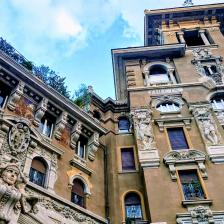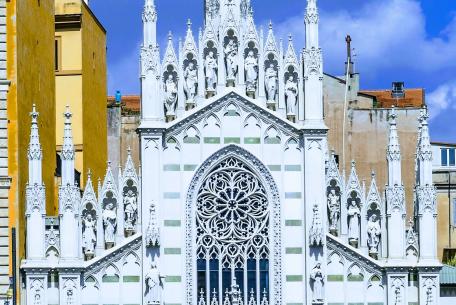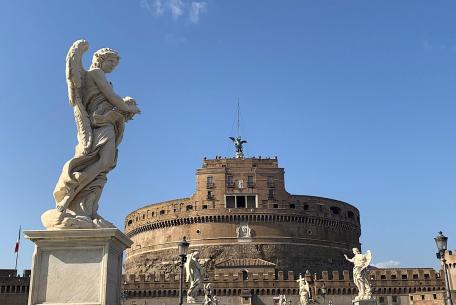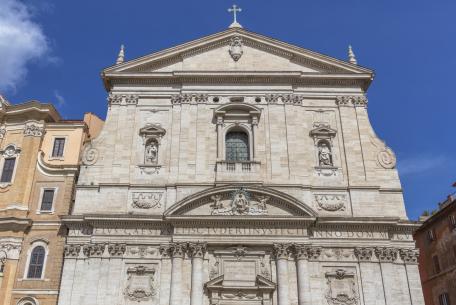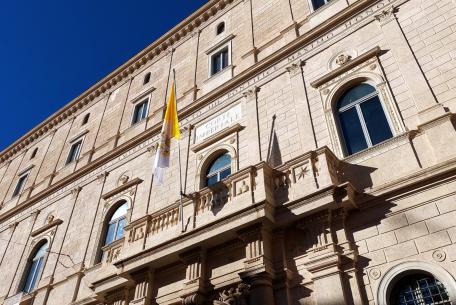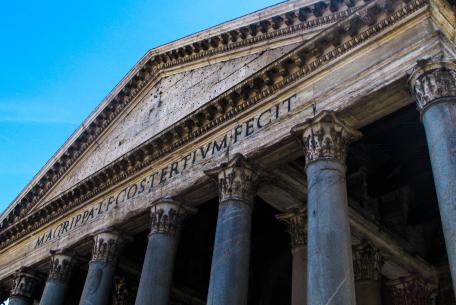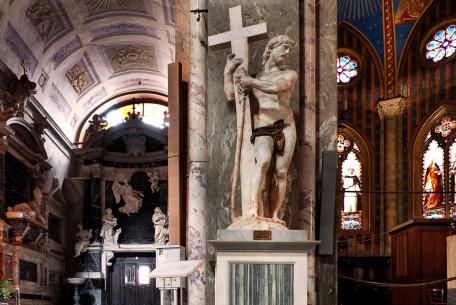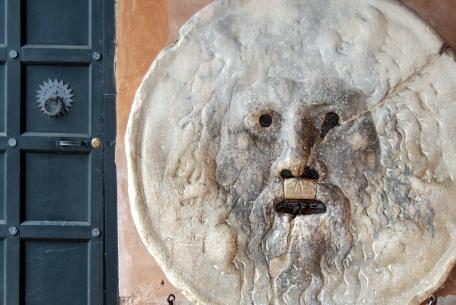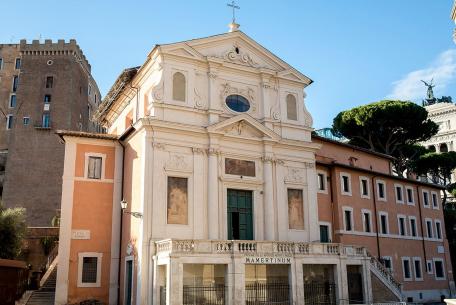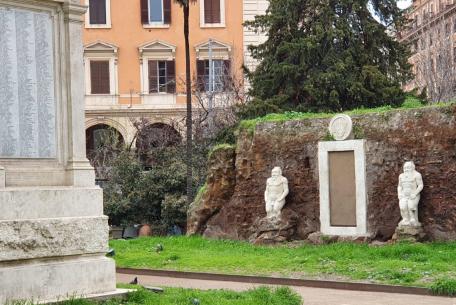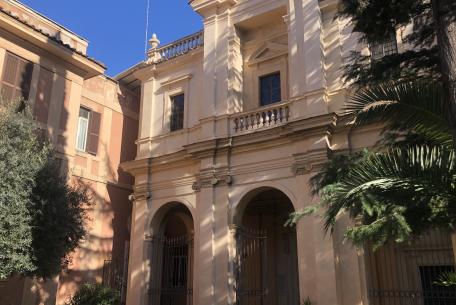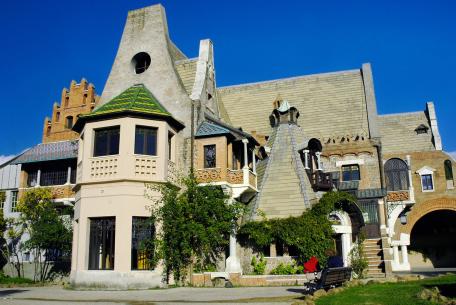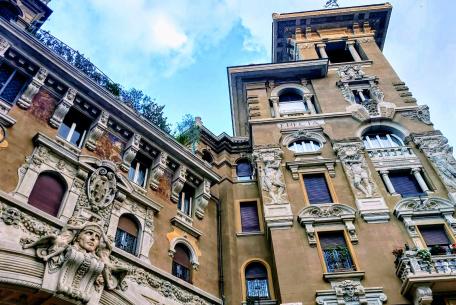
Rome is a thousand-year-old city where the signs of a unique artistic and cultural history have been concentrated over the centuries. Its monuments, archaeological sites and numerous churches hide many unusual and mysterious aspects that often escape the gaze of its visitors.
This itinerary will lead you on a discovery journey of a city that is in some ways unknown, where legends and stories intertwine, some of them surprising, some of them handed down, others documented. It is a journey through which you will be able to look at the capital city in a different light, a light that brings back its unique charm of intrigue and grandeur.
The itinerary winds its way from the center of the city, at times offering well-known monuments such as the Pantheon or Saint Angel Castle which are, however, presented in an unusual way. In other cases, remote locations are suggested, though equally interesting both from a historical point of view and for the mysterious aspects that they hide, linked to an esoteric and alchemical dimension that is often ignored or underestimated.
Rome is undoubtedly a sunny and colorful city, universally recognized as such, this itinerary simply offers the option to go beyond the traditional story of the city and let yourself be amazed by stories and views that will make this city even more appealing before your eyes.
1. Museo delle Anime del Purgatorio - Lungotevere Prati, 12
Inside the church of the Sacred Heart of the Suffrage, defined by the Romans as the "Milan Cathedral in miniature" for its neo-Gothic appearance, is the Museum of the Souls in Purgatory. The church was commissioned in 1894 by the missionary Father Victor Jouët to the Architect Giuseppe Gualandi, to house the association of the Sacred Heart of Jesus for the souls in Purgatory. A fire broke out inside the church, leaving imprints of figures on the pillars and a face on the high altar, visible in a photographic artifact preserved here. Jouët himself attributed the cause of the fire to the souls in Purgatory, who manifested their need for prayers through this event.
Today, the Museum houses a small but evocative collection of documents and relics from the 18th-19th centuries, including breviaries, textiles, wooden tablets and nightshirts, collected by Father Jouët himself from all over Europe, as evidence of the apparitions of the souls of the dead. One example of this is the shirt of the Belgian Joseph Leleux de Mons, on whose sleeve is imprinted the shape of a hand, which he attributed to his mother, who had died 27 years earlier and who appeared to remind him to pray and to change his way of life. The event took place one night in 1789.
2. Castel Sant’Angelo - Lungotevere Castello, 50
Saint Angel Castle is also known as Hadrian’s Mausoleum named after the emperor who commissioned it as his monumental tomb. It owes its current name, however, to a legendary episode that occurred under the papacy of Gregory the Great in 590 A.D., when a terrible plague struck Rome, along with a flood of the Tiber, which decimated its inhabitants. During the procession, organized by the Pope, the faithful worshippers arrived before the Castle and clearly saw in the sky the figure of the Archangel Michael in the act of sheathing his sword: from that moment, the plague stopped devastating the City. Over the centuries, this monument has undergone various transformations, from tomb to fortress, to becoming a papal residence and a prison of the Papal State. Among its guests it counts two famous alchemists: Francesco Borri and, a century later, Count Cagliostro. Linked to the mysterious fascination of Saint Angel Castle is the incredible story of Beatrice Cenci, who, together with her stepmother Lucrezia and her brothers, planned the murder of her father, Count Francesco Cenci; because of the constant violence and abuse perpetrated against his family members. They were discovered and executed by Pope Clement VIII, who never wanted to convict the Count outright, despite the many accusations brought forth against him. It seems that Beatrice’s ghost wanders around the castle on the night of September 11, the date of her death.
In the National Gallery of Ancient Art Palazzo Barberini there is a beautiful portrait dedicated to her by Guido Reni.
3. Chiesa di Santa Maria in Vallicella - Via del Governo Vecchio, 134
The church of Santa Maria in Vallicella hides a small mysterious treasure on the high altar: a 14th century image of the Madonna and Child between two Angels. It is a fresco found on the wall of a building near the church, called "locale della stufa" (stove room), probably used as a public bath.
It is said that a possessed dice player threw a stone at the painting, which then mysteriously began to bleed. Following this episode, the image was detached and kept in the parish church of Vallicella at the white well, today the Church of Santa Maria in Vallicella or Chiesa Nuova thanks to the transformation ordered by Saint Filippo Neri in 1575.
Entering the church, this miraculous portrait is not visible as it is hidden inside the altarpiece, depicting the Virgin and Child adored by angels, a masterpiece by Peter Paul Rubens between 1606 and 1608, during the renovation of the building. Within the altarpiece, the painter had the arduous task of inserting a painting, recognizable by its oval shape, defined as "motorized", to guard the ancient miraculous icon, visible during Saturday vesper mass and during the festivities, when a complicated mechanism of pulleys and ropes is operated, displaying this marvelous fresco in plain sight.
4. Palazzo della Cancelleria - Piazza della Cancelleria, 1
The Palace of the Chancellery owes its name to Pope Damasus, a pontiff of the 4th century A.D. who had a palace built for the cardinal’s seat and the archives next to the church of San Lorenzo in Damaso. The palace was acquired in 1483, thanks to a gambling winnings, by Cardinal Raffaele Riario who, in order to captivate the admiration of his uncle, Pope Sixtus IV, had the palace rebuilt, enlarged and embellished, incorporating the adjacent church and making it one of the first examples of the Renaissance in Rome, also thanks to the support of Bramante. The "noir" notoriety of the palace is due to the events that took place in its premises. It had been the stage of bloody events such as the murder of Pellegrino Rossi, a member of the government of the Papal State, killed on the stairs of the Palace on December 15, 1848, and whose bust is kept in the Chapel of San Lorenzo in Damaso. Centuries later, in 2015, another fact marked the palace notoriety, when the parish priest Grigis was stabbed, with no major nefarious consequences, right on the church parvis.
The palace boasts an inner courtyard, a Renaissance work unanimously attributed to Donato Bramante, for its design on three orders, the first two with arches and the third in brickwork. Inside there are also two important rooms, the Riaria - carpeted with tapestries, used as a sort of waiting room for guests - and the Room of the Hundred Days - so called because of its frescoes by Vasari, who seems to have taken as many days to create them.
5. Pantheon - Piazza della Rotonda
The Pantheon, temple of all the gods, is the result of an impressive engineering acumen, which makes it one of a kind. Its mysterious aspect lies in its perfect spherical architectural structure, symbol of perfection, 43.44 meters by 43.44 meters, whose size celebrate the harmony of form, linking it also to a sort of symbolic numerology connected to astronomy and cosmology. The balance of volumes, the harmony of its proportions, the repetition of the inscriptions of circle and square, the symbol of rationality, also make it one of the architectural examples associated with the golden section. Analyzing the dome, one notices that it is formed by five rings made of 28 coffers. This number, besides being considered perfect as it is the result of the sum of its divisors, is also referred to the moon revolutions on itself to carry out a full rotation. Moreover, from the vault containing the Oculus, that is the only opening of nine meters towards the outside, the sun penetrates to irradiate the inside, and in particular in the summer solstice it projects a circle of the same size of the Oculus on the floor. For this reason, the Pantheon has earned the name of "solar temple," as well as being the emblem of the link between earth and sky in connection with the divine.
6. Basilica di Santa Maria della Minerva - Piazza della Minerva, 42
The Basilica of Santa Maria della Minerva is a very ancient church built on the ruins of three temples dedicated to Minerva, Isis and Serapis, with Gothic elements inside, a rare example in Rome. It is also linked to the figure of Cagliostro, whose real name was Giuseppe Balsamo (1743-1759), a much-discussed figure of the 18th century, who was all the rage throughout the noble courts of Europe for his talents as an alchemist and medium. Founder of a Masonic order based on an Egyptian rite, he demanded to be recognized by Pope Pius VI. His audacity was noticed by the Holy Inquisition, which, also because of his wife’s complaint, arrested him and sentenced him to life imprisonment in a fortress. To humiliate him publicly, he was forced to walk barefoot from Saint Angel Castle to the Basilica of Santa Maria della Minerva, to kneel before the altar and abjure all his writings about the new order and all the objects, that were used during initiation rites in the studio, which he had organized at the French painter Augustin Belle’s, were burned in the square in front of the church.
7. La Bocca della Verità - Piazza della Bocca della Verità, 18
Inside the portico of the Basilica of Santa Maria in Cosmedin, a Catholic church of Greek-Melchite rite, there is a large marble mask with a diameter of 1.75 and a circumference of 6 meters, depicting a screaming faun, probably inspired by a river deity, better known as the Mouth of Truth. Its fame is due to its mysterious power in recognizing truth and lies: whoever declares falsehood will have his hand cut off by it! It seems that since the year 1000, it was mentioned as an oracle in the pilgrims’ guide, Mirabilia Urbis Romae. During the Middle Ages, however, it was indicated as being able to recognize spouses’ infidelity so much so that, because of a trap to which it was subjected, it has not responded since. Legend has it that the wife of a rich man, accused of infidelity, was dragged in front of the Mouth of Truth and at the moment of putting her hand inside, a man in the crowd grabbed her and kissed her. He was thought to be mad and sent away so that, by inserting her hand, the adulteress was saved, only to discover later, that the man was really her lover. In the 1950s it was center stage in a cult scene of the film "Roman Holiday", with Audrey Hepburn and Gregory Peck.
8. Carcere Mamertino - Clivio Argentario, 1
Inside the Roman Forum, under the Church of Saint Joseph of the Carpenters, is the Marmertino Prison, the oldest prison in the city, dating back to the 7th century BC by Anco Marzio. It consists of two levels, the first called "Lautumie", composed of small rooms dug into caves in the tuff, typical of the area of the Capitol Hill. The second level, located on the lower floor and known as "Tullianum", is a circular area, which may be accessed through a hole in the floor of the "Lautumiae" area. The Holy Apostles Peter and Paul were among the illustrious guests, who during their imprisonment, miraculously made spring water gush out to baptize the prisoners locked up in the prison, who later mysteriously disappeared. An imprint left by Peter where he hit his head while descending into the prison is also visible, preserved under a grid, in the "Tullianum".
9. La Porta Magica - Piazza Vittorio Emanuele II
In the gardens of Piazza Vittorio Emanuele II stands a walled door and on each side are two statues depicting the Egyptian deity Bes, discovered during excavations in the Quirinale area. This gate was part of a larger noble complex of the Marquises Palombara, destroyed to make room for the Termini railway station and today’s Piazza Vittorio Emanuele II.
The Marquis was a passionate scholar of alchemy, so much so that he became a member of the Rosicrucians, a secret esoteric order. He surrounded himself with various personalities of the time, who were also passionate about alchemy, such as, among others, Queen Christina of Sweden, who was staying in Rome and Giuseppe Francesco Borri, a doctor with a passion for the occult. It was Borri himself who revealed to the Marquis that he had discovered the way to turn matter into gold. After the mysterious disappearance of the doctor, so it is said, the Marquis found some parchments with symbols engraved on them that he could not decipher, but which he then had engraved on the door. The engraving that fed the belief that the door was the passage to Hell is the palindrome writing "Si sedes non is", which may have two meanings: "If you sit, you don’t go" or, on the contrary, "If you don’t sit, you go".
10. Chiesa di Santa Bibiana - Via Giovanni Giolitti, 154
In the church of St. Bibiana, in the Rione Esquilino, is the Sarcophagus of St. Bibiana, daughter of Flavianus, the Prefect of Rome and a Christian, who was scourged and bound by Apronianus to a column visible in the church, at the behest of the apostate Emperor Julian. Not satisfied, he left her body at the mercy of the dogs, who spared her. From that moment on, Bibiana was venerated as a Saint, so much so that the column where she was tied shows the marks of those who rubbed the column with their hands in adoration. Legend has it that the powder obtained by rubbing the marble was mysteriously prodigal of miraculous events, if mixed with water that flowed from a nearby cloister and with grass collected in the place where the scourging had occurred. In the church you can admire the statue depicting the Saint, sculpted between 1624 and 1626 by Gian Lorenzo Bernini.
11. Casina delle Civette - Via Nomentana, 70
Inside Villa Torlonia, one of the most beautiful parks in Rome, is the Casina delle Civette (House of the Owls), which houses the Museum of Stained Glass Art Nouveau. The Casina takes its name from the sixth room, with two owls depicted on its windows, the work of the Roman artist Duilio Cambellotti. This singular construction, on two levels and with a strongly eclectic style, is unique in its kind and was commissioned by Giovanni Torlonia Jr. It has a fairy-tale and esoteric aspect: it seems, in fact, that the Prince was fond of alchemy. The theme of the owl, as well as being predominant in the stained-glass windows, is recurrent both in many furnishings and in the refined and elegant decorations. The symbolism of the owl has very ancient origins: unlike Greek mythology where the owl symbolized wisdom, the Romans associated it with the idea of death and, in particular, it was considered the bearer of evil omens. In the Middle Ages, owls were even associated with witchcraft and they were believed to be witches in disguise.
12. Quartiere Coppedè - Piazza Mincio
The Coppedè district, designed by Architect Gino Coppedè in 1915 and posthumously completed by Paolo Emilo Andrè, consists of a quadrilateral of flamboyant and extravagant buildings rich in infinite types of decorations. It is an extraordinary triumph of all sorts of animals alternating with angels, cherubs, Roman gods, mythological and sacred figures. The Architect’s visionary eclecticism combines heterogeneous styles, including Gothic, Byzantine, Baroque and Art Nouveau with symbols linked to the esoteric world. The entrance is a large palace, called the Ambassadors’, with a massive chandelier, which is attributed the meaning of the search for light and therefore knowledge, almost as if to signify that whoever enters this district begins an initiation journey towards knowledge. One of the most singular buildings is the Spider Palace, because of the mosaic that represents it, symbol of industriousness and power. The House of the Fairies overlooks Piazza Mincio and consists of three juxtaposed and asymmetrical buildings, whose facades are decorated with symbolic representations dedicated to Rome, Florence, Venice. The Fountain of the Frogs stands out in the same square. Due to its conical shape it is associated with the Holy Grail and named after the twelve frogs that decorate it, like the months of the year and the Zodiac signs. This aspect links it to the symbol of metamorphosis as well as to being a gathering spot for witches.
An urban legend says that, in 1965, after a night at the Piper nightclub, the Beatles took a dip in the fountain.
 Condividi
Condividi












































